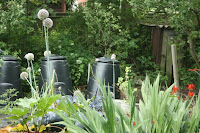I fall over the most interesting and excellent insights into the European World as it is whilst bringing myself up to speed on something that has galvanised me. Having written a little about West Germany - the one I knew about - I wanted to look at the gardens of East Germany - where I wasnt allowed to go - in the 70s. Some fascinating material around but it was the paper by Elizabeth Meyer Renschausen called "Geese in the Garden" which brought me the greatest insights especially into small holdings, allotments and private vegetable gardens and just as in UK economically difficult times leads to a greater interest in vegetable growing and allotments. She gave a paper in USA in 2002 and in it she has a good stab at defining "Small Holder" and "Vegetable Gardener" and how they can overlap....
But the statistic she quotes which puts so much into focus for Germany, its agriculture and the people in the east is this:
"The rapid integration of the GDR (the former East Germany) into the Federal Republic of Germany (the former West Germany) threw 89 percent of those employed in agriculture out of their jobs as early as 1990/91..............Up to two thirds of those unemployed or at most temporarily employed are women. " This was an excellent read.
What she describes is how the Peasant Wife - women's contribution to the agricultural economy - has become such a vital factor as a second and important source of boosting their livelihood either directly by producing food for the family's consumption or as part of the barter economy/payment in kind.
While many such women would prefer waged work because of its social connectivity to others they are aware that the food they grow "...simply tastes better...."
During the difficult years since the wall came down hobby farms and gardens have given many people in the provinces of eastern Germany a way of holding on to a valued sense of meaningful activity, usefulness rather than slipping into feelings of helplessness, grandparents supplying fresh produce for children and even grand children. In fact there has been an attempt to re-evaluate the future of Self Work suggesting that policy makers acknowledge and encourage self-help initiatives.
Dessau - Goethe was apparently totally inspired by Dessau. The formal gardens there are stunning and important to the whole of Europe and the world. In 2000 it was included as a UNESCO World Heritage site. (Leopold III Frederick Franz, Duke of Anhalt-Dessau (b. Dessau, 10 August 1740 - d. Schloss Luisium near Dessau, 9 August 1817 - Wikipedia) and generally known as Prince Franz began its development in the 18th Century, the golden age of formal gardens and much influenced by England and France's gardens.
Gartz on the Oder - near the Polish border gets talked about in "Geese in the Garden" but it is worth remembering that this town is in the one of Germany's National Parks - the lower Oder National Park.
Dresden - so badly bombed in World War Two by the British developed its gardens out of necessity fundamentally on bomb sites. Dresden has started a multicultural garden project I remember being told by a german friend who lived in the country and visited her mother in war-torn Berlin at the end; how she had sat on a bench to eat her lunch and being watched by half starved city people.
Leipzig seems inordinately important if you are physically or virtually interested in gardens of all kinds. The Leipzig Tourism site is in three languages and worth a visit for starters. They have superb photos to tempt and is a good place to start investigating their allotment gardens too.
Lovers of this area included Goethe:
- Goethe in Faust "Mein Leipzig lob' ich mir! Es ist ein klein Paris und bildet seine Leute. (I praise my Leipzig! It is a small Paris and educates its people."
NotesI include this definition which has come out of many conference on sustainability - SARD (Sustainable Agriculture and Rural Development) as a process which meets the following criteria:
* Ensures that the basic nutritional requirements of present and future generations, qualitatively and quantitatively, are met while providing a number of other agricultural products.
* Provides durable employment, sufficient income, and decent living and working conditions for all those engaged in agricultural production.
* Maintains and, where possible, enhances the productive capacity of the natural resource base as a whole, and the regenerative capacity of renewable resources, without disrupting the functioning of basic ecological cycles and natural balances, destroying the socio-cultural attributes of rural communities, or causing contamination of the environment.
* Reduces the vulnerability of the agricultural sector to adverse natural and socio-economic factors and other risks, and strengthens self-reliance.
 Photo courtesy of Wikipedia contributor
Photo courtesy of Wikipedia contributor





































